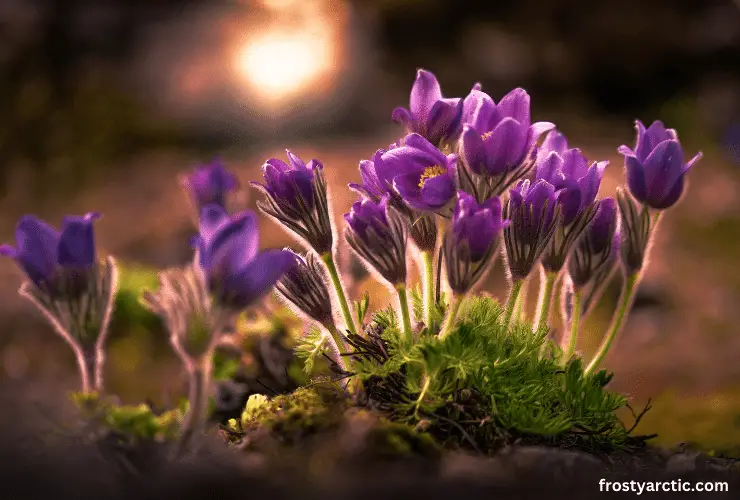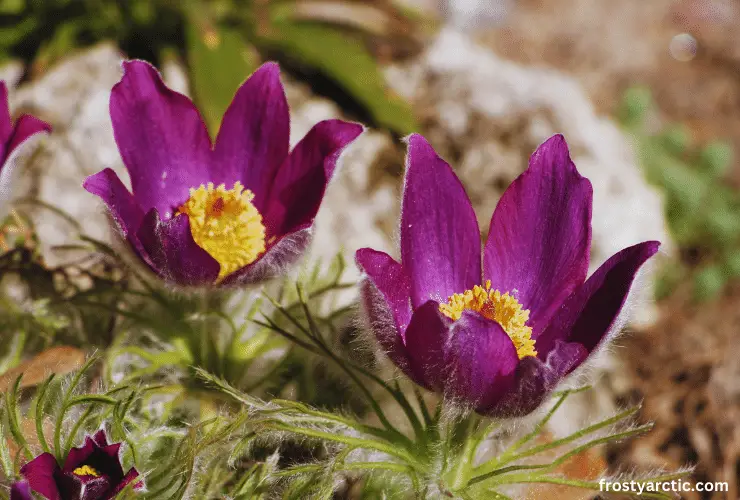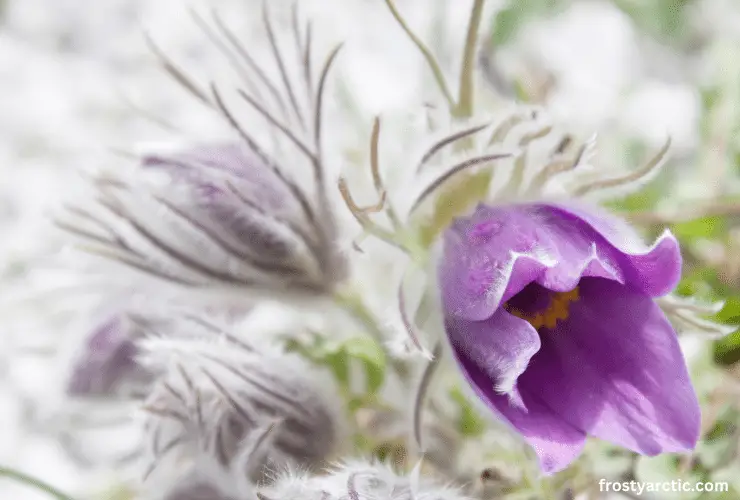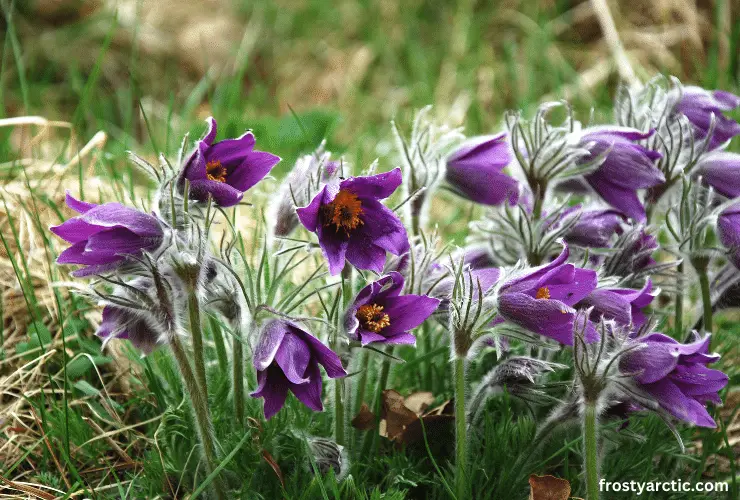The Pasque flower is a low-growing herbaceous plant that blooms in the early spring. It has an impressive adaptation for coping well with adverse cold and dry weather. Though every variant of pasque flower is toxic, it has several medicinal benefits.
Aren’t you curious about what could be those adaptations of the pasque flower? I will discuss this along with its toxicity, medicinal benefits, and uses. Keep scrolling till the end to learn everything about this beautiful pasque flower.
Pasque Flower At a Glance
| Parameters | Details |
| Scientific name | Pulsatilla vulgaris |
| Root | Rhizome |
| Zone | 4-8 |
| Height | 9-12 inch |
| Width | 12-inch |
| Sunlight | Full sun, partial sun |
| Water | Low water tolerance |
| Soil | Well-drained, sandy, and humusy soil |
| pH | Neutral, alkaline |
| Blooming time | Early spring |
| Flower color | Purple, red, white, and pink |
| Leaf color | Grayish-green |
| Uses | Bee friendly, Rabbit proofs, Medicinal uses |
What Is a Pasque Flower?
Pasque flower is one type of low-growing perennial herb. Probably, they are the flowers that generally bloom first in the spring.
The scientific name of this flowering plant is Pulsatilla vulgaris, and they belong to the flower family buttercup. This plant will develop an upright rhizome that acts as a food-storage organ. Their height can reach up to 9-12 inches, and the clumps keep spreading over time.
Mainly the color of their flower is purplish. But you may also find that some gardeners are cultivating variants of pasque flower plants with different colors. The color of their leaves is kind of grayish-green. Pasque flowers are the first bloomers of early spring. The main reason could be that this herb is well-adapted to cold weather.
The colorful flowers with wispy seedheads give this plant a pretty attractive look. Interestingly, you can use pasque flowers to make your garden rabbit-proof. Rabbits will find this plant troublesome while trespassing in your garden.
Why Is It Called Pasque Flower? Pasque Flower Name Meaning
The reason for the naming of Pasque Flower is that it blooms around holy days. People also call this flower the Easter flower.
The word “pasque” comes from the Hebrew word “pasak,” which means “Passover.” Typically, its blooming time is somewhere near Easter and Passover.

People call it the Easter flower or “pasque flower.” On the other hand, people in the Middle East know it as “passifleur.” That means a flower that surpasses or exceeds others.
Where Does Pasque Flower Grow?
Pasque flowers generally grow in meadows or wooded pine forests. It needs full sun and well-drained soil for its healthy growth.
Calcium-rich soil is appropriate for the growth of pasque flower plants. That’s why you may find them growing in some random land where the soil is rich in calcium. They can cope with the dry winter very well. But you must water them regularly during summer.
In this season, you need to water this plant 2-3 times weekly. Ensure that the water reaches deep into the soil. After that, inspect if there is any standing water; otherwise, wet feet will rot at the root of pasque flower plants.
This plant cannot grow in shady places, grows slowly in partial sun, and has tremendous growth in full sun. Along with well-drained soil, pasque flowers are well-adapted to sandy or humus soil. But ensure the soil is not acidic as it can grow only in neutral or alkaline soil.
Where Does Pasque Flower Come From?
The native habitats of this flowering plant are Europe and the British Isles. Generally, you can find them in the dry meadows of the northern and central continental of these two regions.
Pasque flowers aren’t that much available around the world. You can only find them in several particular and specific places. In the UK, you can find them only in 4 areas: Chilterns, East Anglia, Cotswolds, and Lincolnshire.
Due to their suitability for the dry weather, their natural habitat is in the Northern Hemisphere. There, this plant might be dispersed around Asia, Europe, and North America. Also, you can find some species in the Yukon and Northwest Territories of Canada. Moreover, a few of them grow in British Columbia, east of Manitoba.
Are Pasque Flowers Rare?
Yes. Pasque flowers are rare in the wild. Generally, you can only find them in the UK on a handful of sites.
There are numerous variants of the pasque flower. You can cultivate a few of them very easily, whereas some are very, very difficult to find. The main reason behind this rarity is the only scope to propagate this flower herd is from their seeds.

Seeds will fail to grow new pasque flowers if you can’t sow the seeds in an accurate time. If you can’t collect the seed timely, they will blow away with the wind.
On the other hand, when you store those seeds, the seeds will take a longer time to germinate. This precision about accurate time is really difficult to maintain. That’s why pasque flower herbs are scarce.
Pasque Flower Adaptations
This flower has some particular adaptations to survive in extreme adversity. All these adaptations help to survive in cold climates and keep warm, enabling pollination.
Some of the pasque flower adaptations facts are:
- Their stems, buds, and leaves have fine hairs that protect them from excessive cold. Due to the presence of hair, cold air is less able to penetrate inside.
- The flowers of this plant can track the movement of the sun. Consequently, they can absorb solar radiation from the sun to stay warm.
- Another necessary adaptation is its unique arrangement of sepals surrounding the petals. The temperature of the plant increases because the sunlight reflects due to that enclosed petal.
- This arrangement attracts insects for pollination. During the day, these flowers can maintain temperatures above 18 degrees Celsius to attract pollinating insects.
- This plant grows low to the ground, thus protecting the plant from winter.
- Existing rhizomes and root stalks store food for the plant.
Pasque Flower Species: Let’s Talk About
The Pasque flower belongs to Genus Pulsatilla, which consists of almost 30 species. Among those species, Pulsatilla vulgaris blooms in the early spring with beautiful purplish flowers.

There are also numerous variants or subspecies of this flower herb. Many gardeners are recently planting those variants as those bloom flowers of different colors. Some of those variants of the pasque flower are:
- Alba: These variants of the pasque flower can grow up to 20-40 cm. Alba’s flower is relatively bigger than other variants and also has a creamy white color. Besides, they are very slow growing and bloom later than other variants.
- Rubra: The color of the flower of this variant is almost wine-red and has rounded petals. This variant can reach up to 40-50 cm in height.
Interestingly, Rubras have additional blooming seasons. Besides their standard blooming season, you may also find them blooming from September to October.
- Pink shades: From the name, you can already guess this variant consists of pink flowers. This plant can reach up to a height of 20-50 cm.
- Papageno: This type of pasque flower plant has semi-double and fringed flowers. Also, the color of flowers can be a mixture of creamy white, pink, dark red, blue, and violet.
- Red-cloak: People also know them as red bells or red-glocke flowers. This variant of pasque flowers is generally crimson red and blooms slightly later than other variants.
Is Pasque Flower Edible?
No. Pasque flower is not edible. You can’t eat it, as it is slightly toxic. Neither fresh pasque flowers nor dry are edible. If you still eat this flower, it will cause various physical problems, such as-
- Your mental state will be unstable. You can suddenly get excited and sad for no reason. The point is you cannot control your emotional balance.
- It may even cause nausea.
- Moreover, it causes central nervous system paralysis by failing interactions between the brain and spinal cord.
Although it is not edible, it has many medicinal properties and is given to the patient in very small quantities, as too much can be harmful. In short, while it is edible for some animals, humans should avoid it.
Pasque Flower Taste
The taste of pasque flower is quite acrid. Typically, the taste is strong in fresh flowers, but when it dries, the taste becomes conspicuous.
Pasque flower is familiar among people for its medicinal benefits. This herb has a very acrid taste along with huge medicinal quality. Mainly, people collect this herb as soon as it flowers, dry them, and then preserve it. As I said, though it gives a strong acrid taste initially, the taste gradually diminishes over time.
What Is the Pasque Flower Plant Used For?
There is a wide range of uses for this pasque flower. Some of those are:
- Honey: During early spring, these flowers are an invaluable source of honey for honeybees. Then the beekeepers collect the honey from the hives.
- Antidote: It has a vast contributor for medicinal purposes. It is used as an antidote to asthma, stress reliever, tension reliever, eye elements, and treatment of bronchitis and septicemia.
- Stops bleeding: The wool of the seed is very effective in stopping nosebleeds.
What Animals Eat Pasque Flower?
There is evidence that this flower is poisonous. Although this flower is toxic to humans, it is edible for some animals. In general cases, it is deadly for most pet animals. But some wild animals can eat this pasque flower for survival.
Some of the animals that eat these flowers include:
- Rabbits
- Deer
- Groundhogs
- Mice
Interestingly, the Pasque flower does not cause any toxicity in the body of these animals. It is entirely safe for them.
What Did Native Americans Use the Pasque Flower for?
Native Americans used the dried leaves of this flower in various treatments. However, they didn’t use fresh leaves.
- They used to grind the dry leaves of this flower to treat rheumatism.
- Natives also burn leaves and inhale the smoke to cure headaches, as it acts as a painkiller.
- They used to inhale the fumes of the leaves as they were also useful for colds.
- Those Native Americans used this plant for abortion also.
- It was also used to reduce nosebleeds.
Is The Pasque Flower a Medicinal Plant? Medicinal Uses of Pasque Flower
Since ancient times, people have been using this flower for a variety of purposes. Although it has many applications, its contribution to medicine is enormous in most cases.
- Reduce Insomnia
As pasque flower is a sedative herb, it has many medicinal properties in the treatment of insomnia. The flower relaxes the body by reducing the anxiety, stress, and nervousness of people suffering from insomnia. Therefore, you can get rid of insomnia and can sleep adequately.

- Treating Inflammations of the reproductive organs
Experts have proven that this flower has anti-inflammatory effects. That’s why it can reduce the inflammation of the reproductive organs.
- Reduce Tension headaches
Stress is the cause of headaches. As it is a relaxing agent, it can relieve your tension and reduce headaches. Moreover, it contains aspirin Which is very effective in reducing headaches.
- Treat bronchitis
Due to the presence of anti-inflammatory agents relieves inflammation in the lungs. In addition, It can reduce the severity of coughing by clearing mucus. It will also remove your phlegm and cough.
- Septicemia
Septicemia is blood poisoning caused by bacteria. Due to the presence of anti-bacterial agents, it kills the bacteria present in the blood.
- Eye disease glaucoma
Herbal molecules of the plant drain the normal fluid of the eye properly. Thus, pasque flowers will reduce the pressure on the optic nerve of your eyes.
- Treats Asthma
It also reduces inflammation of the lungs and widens the airways. Pasque flowers have an antispasmodic activity that helps to treat asthma.
FAQs:
Is the pasque flower the same as a crocus?
No. The Pasque flower belongs to the family Ranunculaceae, whereas the crocus belongs to the iris family. Thus, they aren’t the same. But somewhere pasque flower is familiar in the name prairie crocus.
Should you deadhead pasque flowers?
It mainly depends on what you want to do. If you want to prevent them from further germinating or want to sow them somewhere else, you can deadhead them. But, if you are planning to reseed, you should not deadhead those seeds carrying fuzzy mop heads of pasque flower.
Is pasque flower poisonous to humans?
Yes. If you ingest any part of this herb raw, you will face gastrointestinal troubles. Besides, this causes complexity during pregnancy and lactation. Every part of this herb can be poisonous and toxic through dermatitis and ingestion.
Is pasque flower poisonous to animals?
Yes. This plant is mostly poisonous to pet animals. The sap of pasque flower plants causes nausea, feelings of intoxication, and paralysis in the central nervous system of animals. However, some wild animals might be quite fond of this plant.
Is pasque flower Evergreen?
No. This herb isn’t evergreen, but you can call it semi-evergreen. The grayish-green leaves start to appear after the flower and remain attractive during summer. After the summer, the leaves dry back and remain like this until the next flower blooms.
Is pasque flower an anemone?
The Pasque flower is closely related to the anemone genus. Also, the family buttercup includes an anemone along with a pasque flower. Due to their similarities, scientists listed them together as anemone Vulgaris.
Conclusion
Pasque flower plants look very attractive due to their beautiful and colorful flowers. There are numerous variants of this herb, and each of them is beautiful in their way.
Yet, they are pretty rare all over the world. You can find them in only a few regions. As they have a large number of medicinal functions, people are becoming more fascinated by this plant day by day.



1 thought on “Pasque Flower (Pulsatilla Vulgaris)| Natural History Museum”